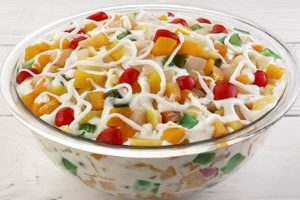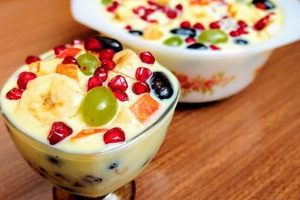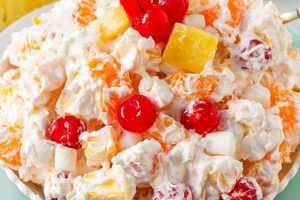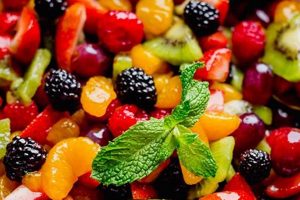Gelatin-based desserts incorporating a variety of fruits offer a refreshing and visually appealing treat. These dishes often involve dissolving flavored gelatin powder in hot water, then chilling the mixture until it begins to set. Fresh or canned fruits are then added and suspended within the gelatin as it cools completely. A simple example might involve a blend of grapes, oranges, and pineapple suspended in lime-flavored gelatin.
Such desserts provide a light and flavorful end to a meal, particularly suitable for warmer weather. The incorporation of fruit contributes vitamins and other nutrients, while the gelatin offers a textural contrast and a satisfyingly jiggly consistency. Historically, these types of desserts gained popularity in the early 20th century as gelatin became more widely available and affordable, providing home cooks with a simple yet elegant dessert option. Their versatility allows for endless variations, accommodating individual preferences and seasonal fruit availability.
The following sections will delve into specific formulation techniques, exploring the diverse array of fruit combinations and flavor profiles possible, as well as providing tips for achieving optimal texture and presentation. Considerations for dietary restrictions and creative serving suggestions will also be addressed.
Tips for Creating Exquisite Gelatin-Based Fruit Desserts
Achieving optimal results with fruit-infused gelatin desserts requires attention to detail. These tips offer guidance for enhancing flavor, texture, and presentation.
Tip 1: Control Sweetness. Adjust the sweetness level by using sugar-free gelatin or incorporating alternative sweeteners. The natural sweetness of the fruit should also be considered.
Tip 2: Layer for Visual Appeal. Create visually striking desserts by layering different colors of gelatin and fruit. Allow each layer to set completely before adding the next.
Tip 3: Prevent Fruit from Sinking. Distribute fruit evenly throughout the gelatin by partially setting the gelatin before adding denser fruits. This prevents them from settling at the bottom.
Tip 4: Enhance Flavor Profiles. Elevate the flavor profile by adding complementary ingredients such as fruit juices, extracts, or spices like cinnamon or ginger.
Tip 5: Choose the Right Gelatin. Experiment with different flavors and types of gelatin, such as flavored or unflavored, to achieve the desired taste and texture.
Tip 6: Proper Mold Preparation. Lightly grease the mold before adding the gelatin mixture to ensure easy removal. Alternatively, use molds specifically designed for gelatin desserts.
Tip 7: Unmolding Techniques. Dip the mold briefly in warm water to loosen the dessert before inverting it onto a serving platter. This ensures a clean release.
By following these tips, one can create visually appealing and flavorful gelatin-based fruit desserts suitable for various occasions.
The following section will offer a selection of exemplary recipes demonstrating these techniques and incorporating diverse fruit combinations and flavor profiles.
1. Gelatin Selection (Flavor, Type)
Gelatin selection significantly impacts the final product in gelatin-based fruit salads. The interplay between gelatin flavor and the chosen fruits determines the overall taste profile. A harmonious pairing elevates the dessert, while a clashing combination can detract from the experience. For instance, a lime-flavored gelatin complements the tartness of berries and pineapple, while an orange-flavored gelatin might pair well with citrus fruits and mangoes. Unflavored gelatin offers a neutral base, allowing the natural fruit flavors to dominate, yet necessitating additional sweetening agents. Conversely, pre-sweetened gelatin simplifies preparation but may limit control over the final level of sweetness.
Beyond flavor, the type of gelatin also requires consideration. Sugar-free varieties cater to dietary restrictions but may necessitate adjustments in other ingredients to achieve optimal texture and taste. Specialized gelatin products designed for specific applications, such as layered desserts, offer unique properties like accelerated setting times or enhanced clarity. Understanding the nuances of these options allows for greater control over the final product, facilitating creativity and customization.
Careful selection of both flavor and type ensures the gelatin complements, rather than competes with, the fruit. This foundational choice directs the overall balance of sweetness, tartness, and flavor intensity, leading to a more harmonious and enjoyable dessert. Ignoring this element can result in a dish where flavors clash or the overall profile falls flat. Thoughtful gelatin selection provides a cornerstone for a well-executed and palatable fruit salad.
2. Fruit Variety and Ripeness
Fruit variety and ripeness profoundly influence the overall quality of gelatin-based fruit salads. A diverse selection of fruits contributes a complex interplay of flavors, textures, and colors. Consider incorporating a balance of sweet and tart fruits, such as berries paired with melon or pineapple combined with oranges. Varied textures, from the firm bite of an apple to the soft yielding of a grape, enhance the sensory experience. The visual appeal is likewise amplified by the vibrant hues of different fruits, creating a mosaic of color suspended within the translucent gelatin. Furthermore, the nutritional value of the dessert is enhanced by incorporating a variety of fruits, each contributing its unique vitamin and mineral profile.
Ripeness plays a crucial role in both flavor and texture. Underripe fruit can lack sweetness and exhibit undesirable firmness. Overripe fruit, conversely, may become overly soft, losing its structural integrity within the gelatin and potentially leading to a mushy texture. The ideal ripeness allows the fruit to retain its shape and contribute optimal flavor. For instance, a perfectly ripe peach offers a delicate sweetness and a pleasant firmness, while an overripe peach might disintegrate within the gelatin, muddying the appearance and compromising the texture. Selecting fruits at their peak ripeness ensures the most desirable flavor and texture contribution to the final product.
Balancing fruit variety and ripeness requires careful consideration. While variety enhances complexity, ripeness ensures each fruit contributes optimally. A thoughtful approach to these elements elevates the gelatin-based fruit salad from a simple dessert to a carefully orchestrated symphony of flavors, textures, and colors. Neglecting these aspects can result in a less satisfying outcome, impacting both the sensory experience and the nutritional value. Therefore, prioritizing fruit variety and ripeness ensures a visually appealing, flavorful, and texturally satisfying dish.
3. Sweetness Balance
Sweetness balance represents a crucial factor in crafting palatable gelatin-based fruit salads. The inherent sweetness of the chosen fruits interacts with the sweetness of the gelatin and any added sugars, creating a complex interplay that defines the final taste profile. An overly sweet dessert can be cloying and mask the delicate flavors of the fruit, while a lack of sweetness can result in a bland and unappetizing dish. This balance hinges on a careful assessment of the sweetness levels of each ingredient. For instance, incorporating very sweet fruits like ripe mangoes might necessitate using a sugar-free or less sweet gelatin variety. Conversely, tart fruits such as cranberries or raspberries may require the addition of sugar or a sweeter gelatin base. The interplay of these elements dictates the final sweetness perception.
Achieving optimal sweetness balance involves more than simply measuring sugar content. The perceived sweetness is influenced by factors such as acidity, temperature, and the presence of other flavor compounds. A tart element can balance sweetness, preventing the dessert from becoming overwhelmingly sugary. Serving temperature also affects perceived sweetness; a chilled dessert may taste less sweet than one served at room temperature. Furthermore, the presence of aromatics like vanilla or spices can modulate sweetness perception, adding complexity and depth. Consider a fruit salad incorporating tart berries, a mildly sweet gelatin, and a hint of lemon zest. The interplay of these elements creates a balanced sweetness profile, allowing the individual flavors to shine through without being overshadowed by excessive sugar.
Successfully balancing sweetness within a gelatin-based fruit salad elevates the dessert from simple to sophisticated. It allows the inherent flavors of the fruit to emerge, complemented rather than masked by added sugars. This delicate balance contributes to a more nuanced and enjoyable sensory experience. Failure to consider this aspect can result in a dish that is either excessively sweet or disappointingly bland. Therefore, a thoughtful approach to sweetness balance is paramount in crafting a truly delightful and well-balanced fruit salad.
4. Mold Preparation
Mold preparation constitutes a critical step in crafting visually appealing and easily-servable gelatin-based fruit salads. The chosen mold dictates the final shape and presentation of the dessert, while proper preparation ensures effortless release and a pristine finish. Overlooking this seemingly minor detail can lead to difficulties in unmolding, potentially damaging the delicate structure of the fruit-infused gelatin.
- Mold Material
Mold material influences both the ease of unmolding and the visual presentation of the salad. Metal molds, while durable, may require more thorough greasing to prevent sticking. Glass molds offer an elegant presentation and often release the gelatin more readily. Silicone molds provide flexibility, facilitating intricate shapes and effortless removal. Choosing the appropriate material depends on the desired outcome and the complexity of the mold design. A simple fluted metal mold might suffice for a classic presentation, while a detailed silicone mold could create a more elaborate and visually striking dessert.
- Mold Size and Shape
Mold size and shape contribute significantly to portioning and visual impact. Individual molds create elegant single servings, ideal for formal occasions. Larger molds, such as Bundt or loaf pans, yield impressive centerpieces for gatherings. The chosen shape, whether simple or intricate, further enhances the presentation. A classic dome shape provides a timeless elegance, while a more elaborate design, perhaps a fluted or sculpted form, adds visual interest. Careful selection ensures appropriate portioning and complements the overall aesthetic.
- Mold Greasing/Preparation
Proper greasing or preparation prevents the gelatin from adhering to the mold, ensuring clean release and preserving the intricate details of the fruit arrangement. Traditional greasing involves lightly coating the interior surface of the mold with a thin layer of cooking oil or non-stick spray. Alternatively, for certain molds, lining with plastic wrap can facilitate easy removal. Insufficient greasing can lead to sticking and tearing upon unmolding, while excessive greasing may leave an oily residue on the surface of the dessert. The appropriate method depends on the mold material and the desired outcome.
- Temperature Considerations
Temperature considerations, though often overlooked, influence the setting process and the final presentation. A chilled mold can accelerate the setting time of the gelatin, particularly beneficial for layered desserts. Conversely, a warm mold might slow the setting process, potentially impacting the structural integrity, especially in intricate designs. Understanding the influence of temperature allows for greater control over the setting process and facilitates the creation of well-defined layers and intricate shapes. This careful temperature management ensures the gelatin sets evenly and maintains its intended form.
Effective mold preparation ensures a flawless presentation and effortless serving of gelatin-based fruit salads. From material selection to temperature considerations, each step contributes to the final product’s success. Neglecting these details can lead to difficulties in unmolding, potentially marring the appearance and structural integrity of the dessert. Careful attention to mold preparation, therefore, represents a crucial element in achieving a visually stunning and readily servable fruit salad.
5. Layering Techniques
Layering techniques represent a crucial element in elevating gelatin-based fruit salads from simple mixtures to visually stunning creations. Strategic layering amplifies the aesthetic appeal by showcasing distinct bands of color and texture, transforming the dessert into an edible work of art. This technique involves carefully setting each layer of gelatin before introducing the next, preventing intermingling and preserving the integrity of individual colors and fruit arrangements. The process requires patience and precision, as each layer must solidify sufficiently to support the subsequent additions. For instance, a layered salad might begin with a base of clear gelatin studded with berries, followed by a layer of lime-flavored gelatin containing sliced kiwi, and topped with a final layer of orange-flavored gelatin with mandarin orange segments. This methodical approach results in a visually captivating dessert with clearly defined strata showcasing the vibrant hues and varied textures of the incorporated fruits.
Beyond visual appeal, layering techniques offer opportunities for flavor and texture interplay. Alternating layers of contrasting flavors, such as tart and sweet, or incorporating layers with varying fruit densities, creates a multi-sensory experience. A layer of dense fruit like chopped apples might be followed by a layer of lighter fruits such as berries, offering textural contrast within each bite. Similarly, alternating layers of sweet and tart flavors provides a dynamic interplay that stimulates the palate. This thoughtful combination of flavors and textures transforms a simple dessert into a more complex and engaging culinary experience. Furthermore, layering offers a means of controlling fruit distribution, preventing denser fruits from sinking to the bottom and ensuring an even distribution throughout the dessert. This manipulation of density and flavor elevates the overall enjoyment and visual appeal.
Mastering layering techniques requires an understanding of gelatin’s setting properties and a degree of patience. Each layer must be allowed to set completely before the next is added, preventing unwanted mixing and maintaining distinct visual boundaries. Failure to allow sufficient setting time can result in blurred layers and a less defined presentation. Furthermore, the temperature of each subsequent layer must be carefully managed to avoid melting the preceding layer. Too warm a mixture can disrupt the established structure, while too cool a mixture can create air pockets and impact the overall cohesion. Successful layering, therefore, necessitates careful attention to detail and a methodical approach. This precision ensures a visually striking and structurally sound dessert, showcasing the vibrant colors and diverse textures of the incorporated fruits. The effort invested in mastering these techniques yields a visually appealing and texturally diverse dessert that elevates the dining experience.
6. Chilling Time
Chilling time represents a critical factor in the successful preparation of gelatin-based fruit salads. Adequate chilling allows the gelatin to fully set, achieving the desired texture and ensuring structural integrity. Insufficient chilling results in a weak, unstable structure, potentially compromising the visual appeal and overall enjoyment of the dessert. Conversely, excessive chilling can lead to an overly firm, rubbery texture, detracting from the intended sensory experience. Understanding the nuances of chilling time allows for precise control over the final product, ensuring a perfectly set and palatable dessert.
- Gelatin Setting Time
Gelatin requires sufficient time to solidify completely. This setting time varies depending on factors such as gelatin concentration, temperature, and the presence of added ingredients. Standard gelatin typically requires a minimum of four hours of refrigeration to achieve a firm set. However, recipes incorporating additional ingredients, such as fruits with high water content, might require longer chilling times. Premature removal from refrigeration can lead to a partially set, unstable structure prone to collapsing or melting. Accurate assessment of gelatin setting time ensures the structural integrity of the fruit salad.
- Temperature Influence
Refrigerator temperature significantly influences the rate at which gelatin sets. Consistent, low temperatures facilitate rapid and even setting, while fluctuating temperatures can lead to uneven solidification and potential structural weaknesses. A refrigerator set too warm may prolong setting time and compromise the final texture. Conversely, placing the mold in the freezer, while tempting for rapid chilling, can cause uneven setting and ice crystal formation, negatively impacting both texture and appearance. Maintaining a consistent and appropriate refrigerator temperature ensures optimal gelatin setting and structural integrity.
- Fruit Incorporation and Setting
The incorporation of fruit introduces additional variables into the chilling process. Fruits with high water content, such as melons and berries, can release moisture as they chill, potentially diluting the surrounding gelatin and increasing the required setting time. Denser fruits may also impact setting due to their temperature and water content. Distributing fruit evenly within the mold and allowing sufficient chilling time after fruit addition mitigates these potential issues, ensuring a uniformly set and stable structure.
- Layered Dessert Considerations
Layered gelatin fruit salads require particular attention to chilling time. Each layer must set completely before the subsequent layer is added to prevent intermingling and maintain distinct visual boundaries. Insufficient chilling between layers can lead to color bleeding and a loss of definition. Allowing ample time for each layer to solidify ensures a visually appealing final product with clearly defined strata showcasing the vibrant colors and textures of the incorporated fruits.
Proper management of chilling time is fundamental to achieving a successful gelatin-based fruit salad. Understanding the interplay between gelatin setting time, temperature, fruit incorporation, and layering techniques allows for precise control over the final product’s texture, stability, and visual appeal. Careful attention to these details ensures a delightful and visually stunning dessert, showcasing the vibrant colors and diverse textures of the incorporated fruits within a perfectly set gelatin matrix.
7. Serving and Presentation
Serving and presentation represent the culmination of the efforts invested in crafting a gelatin-based fruit salad. These elements transform a simple dessert into a visually appealing and enticing culinary experience, impacting perceived quality and enjoyment. Thoughtful presentation elevates the dish, showcasing the vibrant colors and textures of the fruit-infused gelatin. Proper serving techniques further enhance the dining experience, ensuring ease of consumption and maximizing enjoyment.
- Plating Techniques
Plating techniques significantly influence the visual appeal of the fruit salad. Simple yet effective methods include unmolding the salad onto a decorative platter or serving individual portions in elegant glassware. Garnishing with fresh mint sprigs, edible flowers, or a dusting of powdered sugar adds a touch of elegance. More elaborate plating techniques might involve creating intricate designs with fruit purees or sauces, transforming the dessert into a culinary masterpiece. The chosen plating style should complement the overall aesthetic of the fruit salad and the occasion.
- Serving Temperature
Serving temperature impacts both the texture and flavor perception of the fruit salad. A well-chilled salad offers a refreshing and firm texture, particularly desirable in warmer weather. However, excessive chilling can dull the flavors and create an overly firm, rubbery consistency. Serving the salad slightly below room temperature allows the flavors to fully develop while maintaining a pleasant texture. Careful consideration of serving temperature optimizes the sensory experience.
- Portioning and Accompaniments
Portioning and accompaniments further enhance the presentation and enjoyment of the fruit salad. Individual servings in small bowls or glasses create an elegant presentation, while larger portions served family-style encourage sharing. Complementary accompaniments, such as whipped cream, a dollop of yogurt, or a drizzle of custard, add textural and flavor contrast. These additions should complement the fruit salad without overpowering its delicate flavors. Careful portioning and thoughtful accompaniments elevate the dining experience.
- Context and Occasion
The context and occasion for serving the fruit salad influence presentation choices. A casual gathering might call for a simple, unmolded presentation on a platter, while a formal dinner might warrant individual servings in elegant glassware with elaborate garnishes. The chosen serving style should align with the overall tone and formality of the event. Consideration of context ensures the presentation complements the occasion, enhancing the dining experience.
Serving and presentation provide the final flourish, transforming a carefully crafted gelatin-based fruit salad into a truly memorable culinary experience. Attention to these details elevates the dish beyond mere sustenance, engaging multiple senses and enhancing enjoyment. From plating techniques to portioning and accompaniments, each element contributes to the overall impression. Thoughtful consideration of these aspects ensures a visually appealing and palate-pleasing dessert that delights diners.
Frequently Asked Questions
This section addresses common inquiries regarding the preparation and enjoyment of gelatin-based fruit salads. Clarity on these points facilitates successful outcomes and enhances the overall culinary experience.
Question 1: How can one prevent fruit from sinking to the bottom of the mold?
Distributing denser fruits evenly and partially setting the gelatin before adding them prevents settling. Allowing the gelatin to thicken slightly creates a more viscous medium that better suspends the fruit.
Question 2: What alternatives exist for sweetened gelatin?
Sugar-free gelatin options cater to dietary restrictions. Alternatively, unflavored gelatin allows for customized sweetening with natural sweeteners like honey or maple syrup.
Question 3: How does one achieve a firm yet palatable texture?
Adequate chilling time is crucial for firmness. Avoid excessive chilling, which can lead to a rubbery texture. The ideal texture is firm enough to hold its shape yet soft enough to yield pleasantly.
Question 4: Can one incorporate canned fruit into these desserts?
Canned fruit offers convenience. Drain the fruit thoroughly before adding it to the gelatin to prevent excess liquid from diluting the mixture and compromising the setting process.
Question 5: What techniques enhance the visual appeal of layered desserts?
Distinct color contrasts between layers create visual interest. Allowing each layer to fully set before adding the next prevents color bleeding and maintains clear definition.
Question 6: How should these desserts be stored for optimal freshness?
Cover and refrigerate the fruit salad to maintain freshness and prevent it from drying out. Consume within a few days for optimal quality and flavor.
Understanding these fundamental aspects of preparation, storage, and presentation enhances the likelihood of creating a visually appealing and palatable gelatin-based fruit salad.
The subsequent section will offer a curated collection of recipes incorporating the techniques and principles discussed throughout this article.
Gelatin-Based Fruit Salad Recipes
Exploration of gelatin-based fruit salad recipes reveals a complex interplay of factors influencing the final product. Careful gelatin selection, considering both flavor and type, lays the foundation for a balanced dessert. Fruit variety and ripeness contribute textural and flavor complexity, while precise sweetness balance prevents cloying or bland outcomes. Meticulous mold preparation ensures effortless unmolding and a visually appealing presentation. Layering techniques further enhance visual appeal and offer opportunities for flavor and texture interplay. Proper chilling time allows the gelatin to set completely, achieving the desired consistency. Finally, thoughtful serving and presentation elevate the dining experience, showcasing the vibrant colors and textures of the fruit-infused gelatin.
Mastery of these elements allows for the creation of not merely a simple dessert, but a carefully orchestrated culinary composition. Gelatin-based fruit salads offer a versatile canvas for culinary creativity, accommodating diverse flavor profiles, dietary restrictions, and presentation styles. Further exploration and experimentation promise continued innovation within this classic dessert genre.






